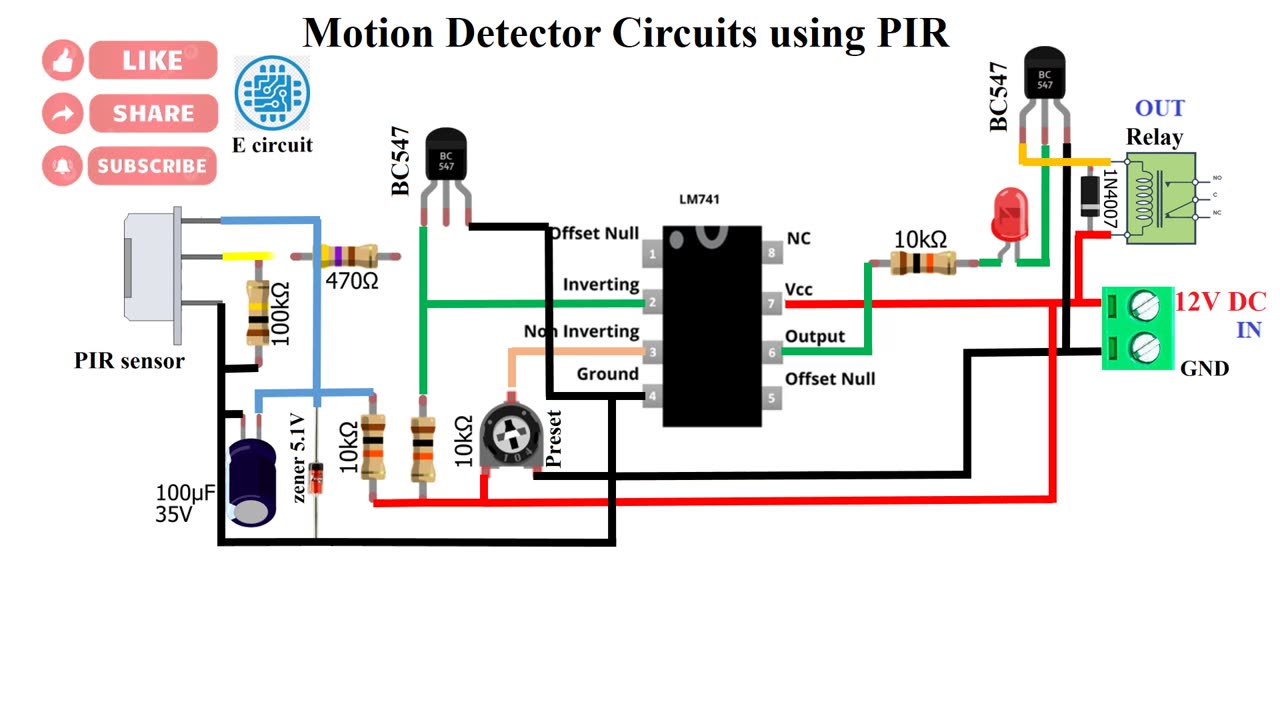Premium Only Content

Motion Detector Circuits using PIR
Hey everyone, welcome to the #E circuit! Today, we're diving into the fascinating world of motion detection with PIR sensors. You've probably seen these used in home security systems and automatic lighting – they're pretty cool little devices.
So, what exactly is a PIR sensor? Well, PIR stands for Passive Infrared. The key word here is "passive." Unlike some sensors that emit their own signals, PIR sensors simply detect infrared radiation that's already present in the environment. Think of it like this: everything with a temperature above absolute zero emits infrared light, including us humans. PIR sensors are specifically designed to pick up changes in this infrared radiation, particularly those caused by the movement of warm bodies.
How does it work? Inside the sensor, there's a special material that generates an electrical charge when it's exposed to infrared radiation. When a warm object, like a person, moves within the sensor's field of view, the amount of infrared radiation hitting the sensor changes. This change in radiation causes a change in the electrical charge, which the sensor then detects.
This tiny electrical signal is then amplified by a built-in circuit, usually involving a Field Effect Transistor (FET). This amplified signal is what triggers the alarm or other connected device.
In this video, we're going to explore five different ways to build motion detector circuits using op-amps and transistors, which are common electronic components. We'll also take a closer look at the pinout of a very popular PIR sensor, the RE200B, so you can easily integrate it into your own projects.
Hey everyone, welcome to the #E circuit! Today, we're diving into the fascinating world of motion detection with PIR sensors. You've probably seen these used in home security systems and automatic lighting – they're pretty cool little devices.
So, what exactly is a PIR sensor? Well, PIR stands for Passive Infrared. The key word here is "passive." Unlike some sensors that emit their own signals, PIR sensors simply detect infrared radiation that's already present in the environment. Think of it like this: everything with a temperature above absolute zero emits infrared light, including us humans. PIR sensors are specifically designed to pick up changes in this infrared radiation, particularly those caused by the movement of warm bodies.
How does it work? Inside the sensor, there's a special material that generates an electrical charge when it's exposed to infrared radiation. When a warm object, like a person, moves within the sensor's field of view, the amount of infrared radiation hitting the sensor changes. This change in radiation causes a change in the electrical charge, which the sensor then detects.
This tiny electrical signal is then amplified by a built-in circuit, usually involving a Field Effect Transistor (FET). This amplified signal is what triggers the alarm or other connected device.
In this video, we're going to explore way to build motion detector circuits using op-amps and transistors, which are common electronic components.
So, if you're interested in learning how to build your own motion-sensing devices, stick around! We're going to break it all down step by step.
-
 LIVE
LIVE
DeVory Darkins
1 hour agoTrump makes shocking announcement as Major ELECTION UPDATE drops after bomb threat
12,560 watching -
 1:09:24
1:09:24
Timcast
2 hours agoZohran Mamdani BLAMES Trump Over Bomb Threats At Polling Locations
102K44 -
 LIVE
LIVE
Right Side Broadcasting Network
4 hours agoLIVE: White House Press Secretary Karoline Leavitt Holds a Press Briefing - 11/4/25
5,083 watching -

The Charlie Kirk Show
2 hours agoGo Vote! + Healthcare and the Shutdown | Dr. Oz, Baris | 11.4.2025
29K3 -
 58:49
58:49
The White House
3 hours agoPress Secretary Karoline Leavitt Briefs Members of the Media, Nov. 4, 2025
3.36K5 -

Sean Unpaved
2 hours agoCarousel Chaos: CFB Week 10 Shocks & Drops, Cardinals Stun MNF, & CBB's Opening Tip-Off Frenzy
6.74K1 -
 1:57:43
1:57:43
Steven Crowder
4 hours agoFailed Hit Job: Another Trump Media Hoax Exposed
274K232 -
 56:36
56:36
The Rubin Report
3 hours agoFox Hosts Stunned by Piers Morgan’s Dark Prediction for NYC Under Zohran Mamdan
25.4K33 -
![GRAY ZONE DEVLOG FOR .3.5 UPDATE!!! [RGMT CONTENT Mgr. | RGMT GL | GZW CL]](https://1a-1791.com/video/fww1/11/s8/1/0/K/B/w/0KBwz.0kob-small-GRAY-ZONE-DEVLOG-FOR-.3.5-U.jpg) LIVE
LIVE
XDDX_HiTower
1 hour ago $0.61 earnedGRAY ZONE DEVLOG FOR .3.5 UPDATE!!! [RGMT CONTENT Mgr. | RGMT GL | GZW CL]
100 watching -
 LIVE
LIVE
LFA TV
16 hours agoLIVE & BREAKING NEWS! | TUESDAY 11/4/25
2,813 watching